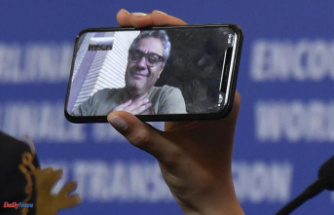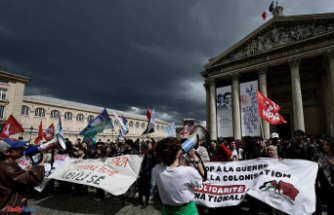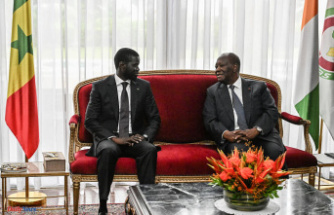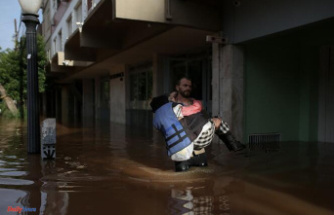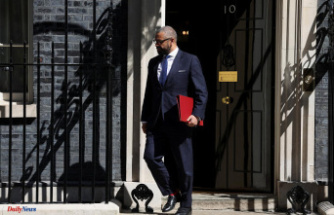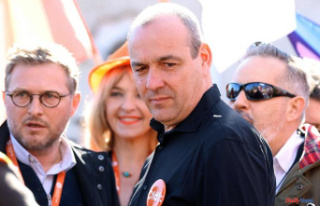On February 24, 2022, the Russian Federation launched the invasion of its Ukrainian neighbor. On September 30, Russian President Vladimir Putin formalized the annexation of four territories in eastern and southern Ukraine, where intense fighting continues. Strongly supported by the West and galvanized by the Ukrainian President, Volodymyr Zelensky, the Ukrainian army recorded several successes and forced Russia to decree, on September 21, a "partial" mobilization.
Are Westerners co-belligerent? What is a war crime? What are the heavy weapons delivered to Ukraine by its allies? What is an air defense system? What does nuclear deterrence mean? In the form of a glossary, a return to the various issues of the war in Ukraine.
Donbass is a Ukrainian region located in the east of the country, on the border with Russia. It is a vast mining and industrial basin of more than 60,000 square kilometers (roughly the equivalent of twice the area of Belgium). Administratively, the Donbass is made up of the oblasts (administrative regions) of Donetsk and Luhansk.
Since the overthrow of Ukrainian President Viktor Yanukovych in February 2014, Donbass has been at the center of an armed conflict between pro-Russian separatists and kyiv. The separatists proclaimed part of these territories "people's republics" of Donetsk and Luhansk. Vladimir Putin decided to recognize the independence of these territories on February 21, 2022, before formalizing their annexation on September 30.
After multiple military setbacks, Moscow is now seeking to avoid humiliation by at least completing the conquest of Donbass, where heavy fighting is ongoing. While Russian forces and separatists have held almost all of Luhansk Oblast since the summer, the Ukrainian army has retained much of Donetsk Oblast. Russian troops are currently concentrating the majority of their efforts there to take the city of Bakhmout, which has become a symbol of trench warfare. Monopolized by the defense of this eminently strategic zone for the fate of Donbass, the Ukrainian forces cannot regain the initiative on other fronts.
Bordered by the Black Sea, Crimea is a peninsula of nearly 27,000 square kilometers located in southern Ukraine. As in the Donbass, the fall of Viktor Yanukovych exacerbates pro-Russian separatist tendencies in Crimea.
Attached to Russia a month later after a sham referendum – the international community denounces a pure and simple annexation – Crimea has a historical, cultural and emotional charge for the Kremlin that the other occupied Ukrainian territories do not have. "In people's hearts and minds, Crimea has always been an inseparable part of Russia," Putin said in March 2014.
Since the beginning of the Russian invasion, the fate of the peninsula, spared from the fighting, seemed disconnected from that of the rest of Ukraine. But the difficulties encountered by the Russian army and the attack on October 8, 2022 on the Crimean bridge – attributed by Moscow to the Ukrainian security services – changed the situation. From now on, the Ukrainians seem determined to reconquer all of their territory, including Crimea. This hypothesis raises the concern of some allies of kyiv, anxious to avoid a risk of further escalation in this conflict.
The North Atlantic Treaty Organization (NATO) is a political-military alliance created in 1949 by twelve countries – including Canada, the United States, France and the United Kingdom. The Atlantic Alliance now includes thirty countries, which undertake to protect each other in the event of attack, according to the principle of collective defense (Article 5 of the Washington Treaty).
Moscow sees NATO, which has grown steadily over the past 30 years, as a threat. Before the war, there was a consensus within the Alliance not to integrate Ukraine in order not to offend Russia. After a year of conflict, the idea is no longer completely ruled out. Ukrainian President Volodymyr Zelensky's September 30, 2022 request for "accelerated membership" is unlikely to succeed, however, as all NATO decisions are taken unanimously.
The Allies, which provide military equipment as well as significant financial assistance to Kyiv, “have agreed (…) to continue to support Ukraine for as long as necessary”.
As a direct consequence of the Russian invasion, on May 18, Sweden and Finland formally requested to join NATO. It had to be an express process. But eight months after the two countries applied, the Alliance's "open door" policy has run into a giant snag. Turkish President Recep Tayyip Erdogan continues to block the accession of the two Nordic countries. In his eyes, Stockholm and Helsinki must first stop defending Kurdish militants who have taken refuge in their territories.
A co-belligerent fights a common enemy with another, without being bound to it by a formal alliance, or helps it to supervise its military operations. The Westerners have been repeating it for a year: they are not "parties to the conflict", according to the established legal formula, and their direct military involvement in Ukraine against Russia is excluded. It is a question of containing the fighting on Ukrainian soil, without abandoning the population to its fate.
On the issue of arms deliveries, international law is quite clear. A country is not considered co-belligerent as long as it only sends or funds equipment. The same goes for training soldiers. "Assisting a country attacked by arms deliveries is to act within the framework of collective self-defense and that does not make these countries belligerents", explains to Le Monde Bruno Tertrais, deputy director of the Foundation for strategic research. On the other hand, whenever a country coordinates these forces, even remotely, or plans combat operations, it becomes a "party" to the conflict.
How far can allies go? Sending tanks can be seen as a way to help Ukraine liberate its territory from the aggressor. Could it be the same with the delivery of long-range missiles, capable of hitting targets far away on Russian soil, or fighter jets? There are also gray areas in intelligence. Does the data provided by satellites have direct operational utility? "The question of thresholds is not settled by international law," confirms Julia Grignon, specialist in the law of armed conflict at the Institute for Strategic Research of the Military School.
“The question, in fact, is not so much whether such and such a measure constitutes in itself an act of war (…), but whether it is likely to be interpreted as such by the Kremlin. It's a narrow ridgeline,” wrote our journalist Marc Semo in May.
In one year, more than 39,000 alleged war crimes have already been registered on the Warcrimes.gov.ua site, an "IT hub" for Ukrainian institutions. No legal text alone codifies all war crimes. The definition of these crimes derives essentially from two international treaties:
The most recent definition of what constitutes a war crime is given in Article 8 of the Rome Statute, which entered into force in 2002. Prohibited acts in wartime are numerous: torture, destruction of property not justified by military necessity, deportation, hostage-taking, sexual violence, deliberate attacks against the civilian population, killing or wounding a combatant who has laid down his arms, looting, use of asphyxiating or poisonous gases, etc.
These are weapons with a very high destructive capacity, such as cannons, mortars or missiles. These weapons are also called collective weapons, because they require several people to use them. Tanks (whether heavy or light), helicopters and military aircraft also fall into the category of heavy weapons.
From the start of the invasion of Ukraine, the West first delivered to kyiv light armaments, such as portable missile launchers. Many heavy equipment then came to complete the system. Among these weapons, multiple rocket launchers, anti-aircraft weapons, howitzers and missiles played a key role in the success of the Ukrainian counter-offensive in September.
After weeks of procrastination, Ukraine's allies decided at the end of January to take a step forward by agreeing to deliver heavy tanks to kyiv. In total, Ukraine will be able to count on at least a hundred Western armored vehicles. However, their delivery will take time. The boss of Rheinmetall, the German manufacturer of the Leopard 2, explained that it would be impossible to deliver these tanks before the end of the year.
This is another sign of the upgrading of the Ukrainian army: the United States confirmed, on December 21, the delivery of a Patriot air defense system to troops in Kiev. Considered one of the best anti-aircraft defense devices in Western armies, the Patriot is effective against ballistic and cruise missiles, which Russia makes extensive use of in Ukraine to destroy energy infrastructure.
This Patriot battery completes the previous deliveries of surface-to-air defense equipment made by the West. In early October, Germany sent an IRIS-T medium-range battery (acronym for Infra Red Imaging System Tail/Thrust Vector-Controlled). In November, the United States, Spain and Norway delivered eight Nasams (acronym for Norwegian Advanced Surface to Air Missile System) long-range systems and an undetermined number of batteries short-range Aspide. For its part, France sent two Crotale short-range batteries.
According to kyiv, these materials, added to the Ukrainian systems inherited from the Soviet era, would make it possible to destroy part of the projectiles fired. In an interview published on December 15 by The Economist, General Valeri Zaluzhny, Commander-in-Chief of the Ukrainian Armed Forces, claimed that 76% of Russian drones and missiles did not reach their target.
In Ukraine, Russia uses Iranian Shahed-136 drones, "kamikaze" drones, with a range of 2,500 kilometers. Tehran acknowledged, in November, having delivered these devices to Moscow, but before the start of the conflict. Ukrainian President Volodymyr Zelensky considers Iran to be minimizing the number of devices supplied.
The Shahed-136 is manufactured by the Iran Aircraft Manufacturing Industrial Company. Isosceles in shape, it is 3.50 meters long and 2.50 meters wide, weighing about 200 kg. Its nose contains an explosive charge as well as the optics necessary for a precision attack. Fired in bursts, these drones can fly at over 185 km/h.
The Russians began using Shahed-136s in September to undermine civilian morale and try to stem the counteroffensive in the Kharkiv region of eastern Ukraine. These drones cannot be shot down by Stingers (portable surface-to-air missiles) supplied by the United States, as they are not equipped with night vision systems.
Nuclear deterrence is a defensive military doctrine. It is based on the fear of mutual destruction in the event of a nuclear attack, insofar as this would lead to a response. It thus rests on a balance of terror.
Until now, Russian nuclear doctrine provided for the use of such a weapon only in response to an existential threat to Russia. In 2018, Vladimir Putin explained that the prerequisite would be the detection by Russian radars of the triggering of a nuclear strike in the direction of his country.
But, since the start of the invasion of Ukraine, the threat of recourse to nuclear weapons has been regularly fueled by the head of the Kremlin. On February 24, 2022, the first day of the attack, he threatened those who tried to get in his way with "consequences never before seen". He returned to the charge on September 21, ensuring that he was ready to use "all means at [his] disposal to protect Russia and [his] people", thus placing himself in the posture of the attacked.
Is the Russian president ready to lower the threshold for the use of nuclear weapons, considering that an attack on his territorial integrity is sufficient – as long as we accept the annexation of four territories in eastern Ukraine? ? The definition of an existential threat is therefore subject to interpretation. Should these repeated exits be seen as a tool for internal galvanization or as clear signals addressed to the West? The ambiguity is maintained. Faced with these threats, Westerners, led by the United States, refuse to escalate and maintain the vagueness of the response in the event of action being taken.
It is a paramilitary organization, made up of Russian mercenaries, which maintains close – but unofficial – links with the Russian authorities. Since 2012, this "phantom army" of Vladimir Putin intervenes in theaters of operations where Moscow has not officially sent any soldier to fight: the Central African Republic, Syria, Libya, Mali, Madagascar or Ukraine, even before the invasion by the Russian regular army.
According to Washington, some 50,000 Wagner men are in Ukraine: 10,000 are mercenaries and 40,000 have been recruited from Russian prisons. Other BBC estimates put the figure at 20,000 prisoners recruited from Russian prisons.
In January, the Wagner Group played an important role in the Battle of Soledar in eastern Ukraine. The boss of the organization, Yevgeny Prigojine, had claimed that the assault on the city had been carried out "exclusively" by members of Wagner. The Russian army had praised, a few days later, the "courage" of these fighters, a rare sign of recognition between these two often rival structures.
The group has been sanctioned by the European Union since 2021 and considered an international criminal organization by the United States since January 2023.
What effect do the seasons have on warfare? In theory, the winter period slows down military maneuvers. In Ukraine, the rain and mud have thus made it more difficult to move armored vehicles and guns, which also leave traces on the ground, making them easier to spot. Despite their tracks, heavy tanks can also be hampered by loose terrain.
Another important element to take into account is the spring thaw – the famous raspoutitsa (“the time of bad roads”) – which cut off Napoleon's retreat in 1812 and stopped German armor in 1941. This phenomenon, which transforms every year the Ukrainian soils in quagmire, should favor the Russian forces, today essentially confined to defensive positions.
Note that winter has not completely frozen the front line – intense fighting is taking place in the Donbass. This relative "winter break", however, was to allow Moscow to regenerate its troops and equipment. The Ukrainians and their allies now fear a new major offensive before the end of winter or in the spring.


